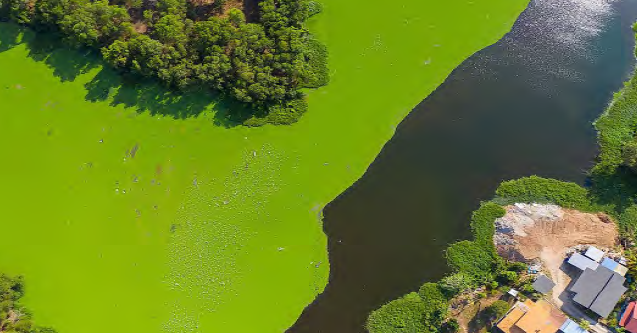by Dennis Song
The waters of California, from its tranquil pearly lakes to the tempestuous salty coasts, are turning dollar green. Researchers have recently hypothesized that the transformation is induced by agricultural run-offs and unprocessed human feces. And unsurprisingly, civilians’ aquatic amusements and bodily health have become the unwilling victims of the water pollution.
Recognized by the United Nations to be the most prevalent water quality problem, eutrophication is an ecologically disruptive accumulation of organic matter from algae overgrowth that colors the waters green. While eutrophication has always been embedded in California’s urban history, researchers have observed intensified pollution in recent years.
According to the Proceedings of the National Academy of Sciences, the 426-mile-long coastline, Southern California Bight, is experiencing enhanced eutrophication from “the localized discharge of anthropogenically enhanced nutrients from […] 23 million people.” The surplus of aquatic organic content leads to increased photosynthetic algal blooms––ultimately toxifying the water.
“At a glance, the sparkling waters of the Southern California coast appear healthy,” wrote UCLA’s Institute of the Environment and Sustainability. However, deeper into the ocean, the waters’ cyanobacteria blooms are harming California’s critical aquatic and coastal ecosystems.
The algal blooms result in a decrease of dissolved oxygen content which directly kills fish by producing unsuitable living conditions. Furthermore, eutrophication converts the native biomass composition to excessive phytoplankton that are not part of the native food chain. As a result, biodiversity rapidly declines in eutrophicated lakes.
Eutrophication cultivates economic loss and undesirable, chemically toxic local living conditions.
Martha Sutula from the Southern California Coastal Water Research Project (SCCWRP) warned the public that eutrophication can endanger health. Primarily, sea creatures, especially crabs, uptake green algae and accumulate domoic acid, a toxin, in their flesh. If ingested by humans, the toxin causes problems ranging from vomiting, loss of short-term memory, coma, to potential death.
To protect public health, multiple crab fisheries’ have experienced emergent closures under state order due to increased algae blooms. Although the California Department of Public Health (CDPH) and the California Department of Fish and Wildlife (CDFW) are certain that strict testing measures are effective in protecting seafood consumer’s health, periodic closures are financially difficult for fisheries. Between 2015-16 alone, the direct economic impact from closures was $29.7 million for the Dungeness and rock crab fisheries.
Furthermore, unlike citizens protected by state health regulations, other mammals are not so lucky. Annually, hundreds of sea lions along the California coast experience brain damage caused by domoic acid. Their nervous systems are destroyed, causing disorientation and seizures.
House pets are also victims of algae poisoning. California’s Clear Lake, a lake with a record of seven years of eutrophication, fatally poisoned a dog after the pet drank the green water in 2021. Moreover, according to a local resident, the lake “smell[s] rotten in the warm months” and “[f]ishing tournaments were cancelled due to the noxious scum.”
As the oldest lake in North America, the once clean Clear Lake, a lake north of Napa and the San Francisco Bay, was an essential food source and sacred cultural land for thousands of years. Now it is rapidly losing its ecological, economic, and recreational health to the hands of urbanizing anthropogenic pollution.
Clear Lake is only one of the more than forty eutrophicated lakes in California.
Agricultural run-offs and sewage wastes are prime causes of eutrophication. Half of the amount of phytoplankton can be attributed to human pollution, wrote UCLA. Similarly, the Chinese Government reported that one severely eutrophicated lake’s phosphorus content dropped by 43% after improving the local sewage system.
However, for the Southern California Bight coastline’s sheer 426-mile length, improving the failed Southern Californian sewage processing system is not a prioritized solution. This is because the treatment would be a highly costly, multi-step process, said Researcher Daniele Bianchi from the Southern California Coastal Water Research Project (SCCWRP).
Instead, environmental scientists state-wide are conducting research to find alternative, innovative solutions to eutrophication that may improve the health of coastal Southern Californians. For example, the Ocean Protection Council Science Advisory Team Working Group (OPC SAT) is currently investigating the use of bull kelp agriculture to remedy marine eutrophication.
When grown in large quantities, seaweeds can remedy eutrophication by limiting algae from up-taking organic compounds. They “steal” organic contents from algae blooms for themselves to grow. In optimal conditions, bulk seaweeds can grow six inches daily. Then, farmers can harvest the aquaculture products and remove nutrient contents from water bodies directly.
“Seaweed is a perfect solution to marine eutrophication,” indicated OPC SAT.
But scientists expressed demand for caution when approaching bulk seaweed aquaculture as a means to reduce eutrophication. Researcher Daniele Bianchi envisioned that large scale aquaculture may cause unintended disturbances to the coastal ecosystem for its sheer wide sea floor coverage.
In contrast, UC Santa Barbara researchers believe that California is ready for seaweed aquaculture. In fact, politicians are pushing for bills and a “signed executive order that could catalyze the expansion of the U.S. aquaculture industry,” explained UCSB in a recent news-release.
Moreover, researchers are investigating seaweed cultivation’s impacts — not only ecologically in capturing nutrients, but also economic benefits to food and industry sectors. Bulk seaweeds are processed into “fuels, fertilizers, and food,” notes UCSB. That said, unlike other remedy methods, exemplified by improving the sewage system, seaweed aquaculture can make a fortune and even possibly boost local economies.
However, more studies are needed to sustainability practice bulk seaweed farms.

